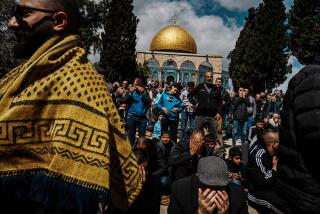Christmas Revisited : More Somber Armenian Holiday to Be Celebrated Monday
- Share via
It was the week after Christmas but no one in the La Crescenta home ofKahren and Caroline Beniasians had had enough of the holiday spirit.
The brightly decorated tree still stood, and a display of pastries, dried fruits and nuts brightened the living room table.
The reason for the festive air was that the Beniasians and their children--Karinae, 18, and Corinne, 11--have another Christmas to anticipate: Armenian Christmas, which is celebrated on Monday and has a more contemplative mood than the rest of the holiday season.
The Beniasians family is actually multicultural: Caroline Beniasians has American roots reaching back to the Civil War, and Kahren Beniasians is an Iranian-born Armenian, who strongly identifies with his Armenian heritage. Their daughters speak both English and Armenian fluently, and the family celebrates Christmas twice, in both the European and Armenian styles.
“We try to keep the traditions,” Caroline Beniasians said.
For the girls, each of the two holidays has a distinct feeling, and they say that without both of them, their Christmas season wouldn’t seem complete.
The Beniasians’ Christmas season began mid-December, when the family picked out a tree and Caroline Beniasians baked traditional Armenian pastries with her mother-in-law, Ofick Beniasians, who lives with the family.
The two women--with the help of Karinae and Corinne--used recipes, including some old handwritten ones, that had been handed down by Ofick Beniasians’ mother, who was born in Armenia.
Caroline Beniasians--who has learned to speak and read Armenian fluently--is currently transcribing the recipes onto a computer in English, along with American holiday recipes from her own family, to create a family cookbook to give to her daughters.
Christmas in December was filled with feasting and gifts. On Christmas Eve, the Beniasians had more than 20 of their Armenian relatives for a party, which included a lavish American meal and songs.
The next morning, the family opened its gifts and spent the day together playing.
Now, they are awaiting their second Christmas, which they said will be a more solemn religious occasion.
For centuries, Armenians have observed Christmas on Jan. 6--the day Christ’s birth is said to have been revealed to the three wise men, as well as the day he is said to have been baptized.
Before AD 336, the birth was celebrated throughout the Christian world on Jan. 6. But during the 4th Century, most Western churches followed Rome in switching the celebration to Dec. 25.
Early Sunday evening--Christmas Eve--some of the Beniasians will attend Mass at St. Mary’s Armenian Apostolic Church, receiving pieces of blessed bread to bring home.
“It is not forced that we have to go,” Kahren Beniasian said. “Whoever wants to go, whoever has the feeling, can go, and if I go, it’s mainly because I am taking my mother.”
After church, the family will go to the home of Kahren Beniasians’ sister for a meal of a traditional Armenian vegetable souffle, and several varieties of Iranian stew with rice, from the family’s Iranian past.
Before the meal, however, everyone will drop a few crumbs of the blessed bread into glasses of wine, and drink--the ritual of remembering Christ’s last supper.
On Christmas morning, the family will go to church, then spend the rest of the day visiting friends and relatives, to wish them well for the new year. A priest may also stop by the house to offer a blessing for the next year. There will be no gifts and little frivolity.
Armenian Christmas is “more like you are celebrating Jesus’ birth,” Corinne said. “We spend more time remembering him.”
Caroline, who never celebrated an Armenian Christmas until she met her husband in Iran, said the religious emphasis of the holiday is an appropriate culmination for the season of festivities.
“I wouldn’t have it any other way,” she said.


